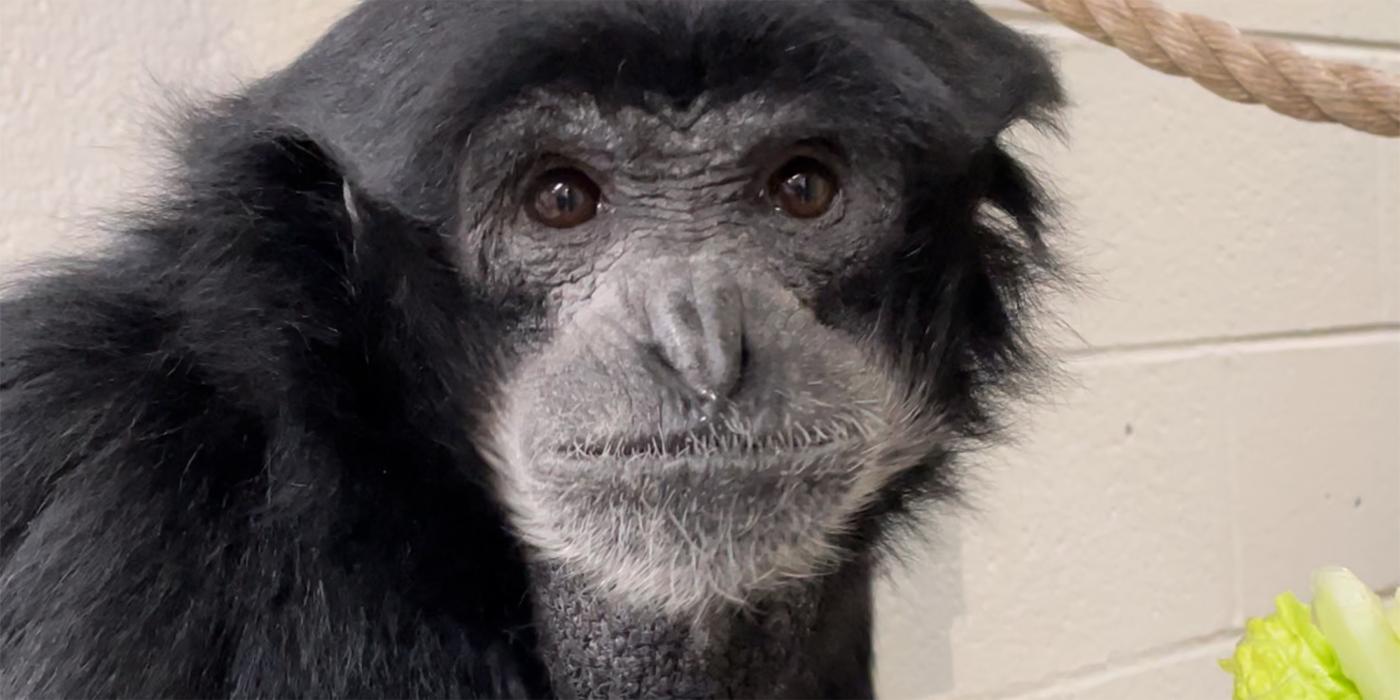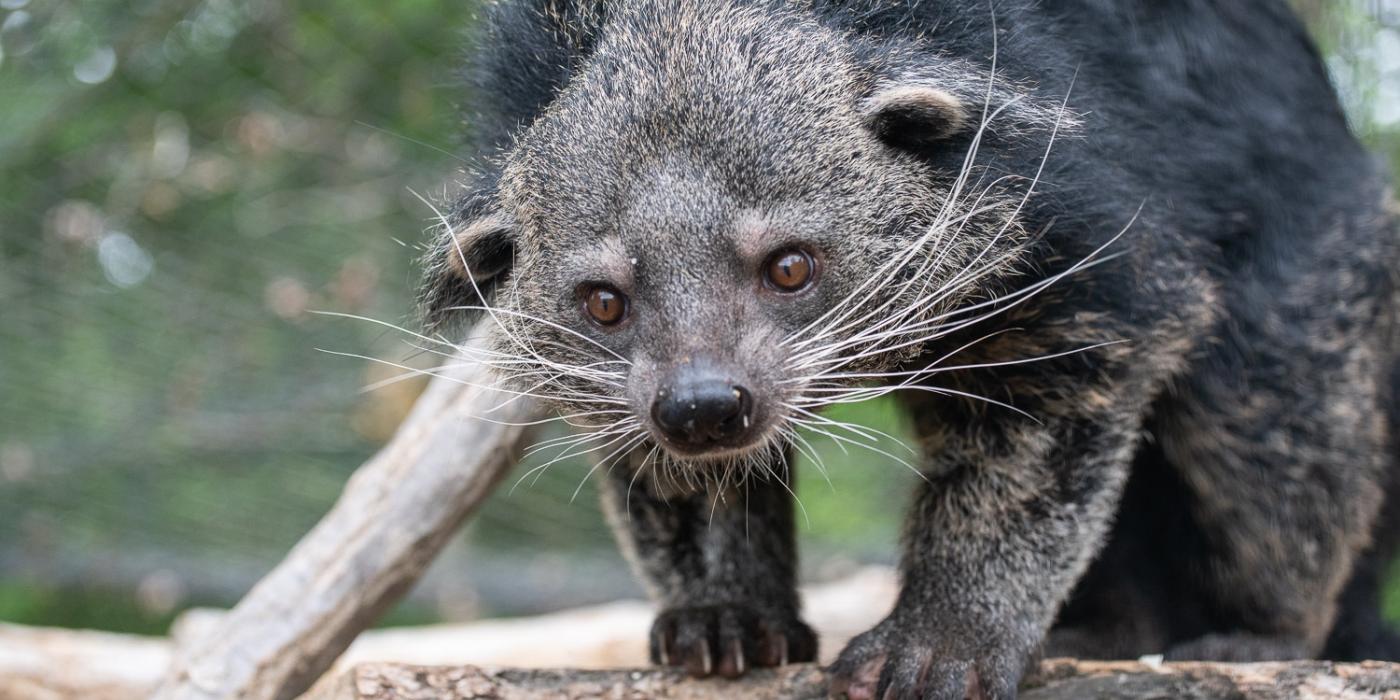Say Hello to Our New Siamangs, Adi and Guntur

The cool new couple at Gibbon Ridge are smart, sweet and specialize in singing duets—meet siamangs Adi and Guntur! The dynamic duo arrived at the Smithsonian’s National Zoo last fall and will make their debut once the weather warms. Get to know our gibbons in this Q+A with primate keeper Carly Hornberger.

What are Adi and Guntur’s personalities like?
It has been really fun getting to know Adi and Guntur over the past few months!
Ten-year-old female Adi came to us from the El Paso Zoo in Texas. Her full name is Adinda, but her previous keepers called her Adi. We thought that nickname was cute, so we decided to keep using it. Adi is head-strong, determined and smart—she tells keepers what she wants when she wants it! Puzzle feeders seem to be no match for her smarts; she’s already mastered many of them and can extract treats in no time. Adi is also eager to train and has leaned several husbandry behaviors in the short time she has been here.
Seven-year-old male Guntur is originally from the Virginia Zoo. He is a super sweet guy—laid-back, easygoing and carefree. He always seems happy to see keepers and will come up to the mesh to say “hi” right away! He never seems to be in a rush to go anywhere or do anything, but he will work very hard on enrichment and during training sessions.
How do you tell Adi and Guntur apart?
One of the easiest ways to tell our siamangs apart is to look for a little tuft of hair on Guntur’s rump. Only male siamangs have a “genital tuft” in the spot where a tail would be. (Siamangs are small apes and, unlike monkeys and lemurs, do not have tails.) Guntur also has more hair on his chest than Adi.
Why did they come to the Zoo?
Since we had extra space at Gibbon Ridge, we requested a potential breeding pair from the Gibbon Species Survival Plan. It just so happened that Guntur and Adi are sexually mature and at an age when they would naturally disperse from their natal groups. Although they do not yet have a breeding recommendation, it is likely they will have one in the future. Based on their genetics, they are a good match for one another.
How are they getting along?
Guntur and Adi get along well! When we initially introduced the pair, there was a “howdy” door between their enclosures. This enabled Adi and Guntur to see, smell and interact with one another through a protective mesh barrier.
These introductions took place over the span of two weeks. During the first week, they only had howdy access during the day. We looked for positive interactions such as grooming, playing, sitting near each other and singing together. If the introductions had not gone well, we would have seen open-mouth threats, teeth chomping and displaying.
In week two, we gave them “howdy” access both during the day and overnight. We continued to see positive behaviors from both siamangs, so the final step was giving them full access to one another. They have been fully living together since late January!
What husbandry behaviors are they learning?
One of the ways we monitor the health and wellbeing of our siamangs is through positive reinforcement training. Every day, we teach our animals behaviors that enable them to participate in their own health care. If they choose to participate and do the correct behavior, they receive lots of praise and a favorite food as a reward. Apples, bananas and grapes are a big hit with Guntur and Adi!
Both have mastered presenting their hands and feet on cue. This behavior enables us to get an up-close look at our animals and check for any injuries or oddities that may need veterinary attention. The siamangs will also sit on a scale so we can obtain their weights once a month. Eventually, Adi and Guntur will be able to present other body parts, too, such as their hip, shoulder and belly. For now, these behaviors are a work in progress.
Do they have any favorite enrichment items?
We don’t know what their favorites are yet as we are still getting to know them, but they both enjoy using enrichment! While we are setting up their enclosure, Adi will stomp and tap her feet, a cute behavior that lets us know she’s ready to dig in to her toys and puzzle feeders! Guntur, on the other hand, is very patient and will calmly wait.
How did Bradley and Ronnie react to the new couple in town?
Our older siamang pair are getting used to their new young neighbors. Since siamangs are highly territorial animals by nature, Ronnie and Bradley are going through an adjustment period to the presence of two additional siamangs in the vicinity. Guntur and Adi have visual and auditory access to Bradley and Ronnie, but they will never physically meet or share the same space, just like in the wild.
When will visitors be able to see the new siamangs?
Once temperatures start to warm up, Guntur and Adi will make their debut at Gibbon Ridge!
This story appears in the March 2022 issue of National Zoo News. Searching for the scoop on siamangs Bradley and Ronnie? Read Carly Hornberger’s previous update about them!
Related Species:



